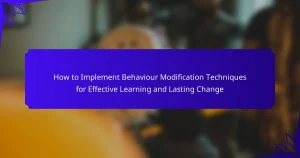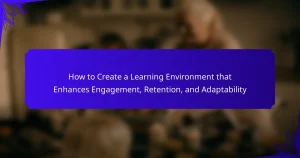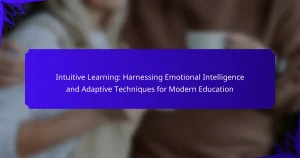Educational conditioning practices enhance engagement, retention, and adaptability in learning environments. These methods promote active participation and personalized experiences through techniques like gamification and adaptive learning technologies. Research shows that implementing these practices can increase knowledge retention by up to 30%. By tailoring educational approaches to individual needs, educators can foster more inclusive and effective learning experiences.
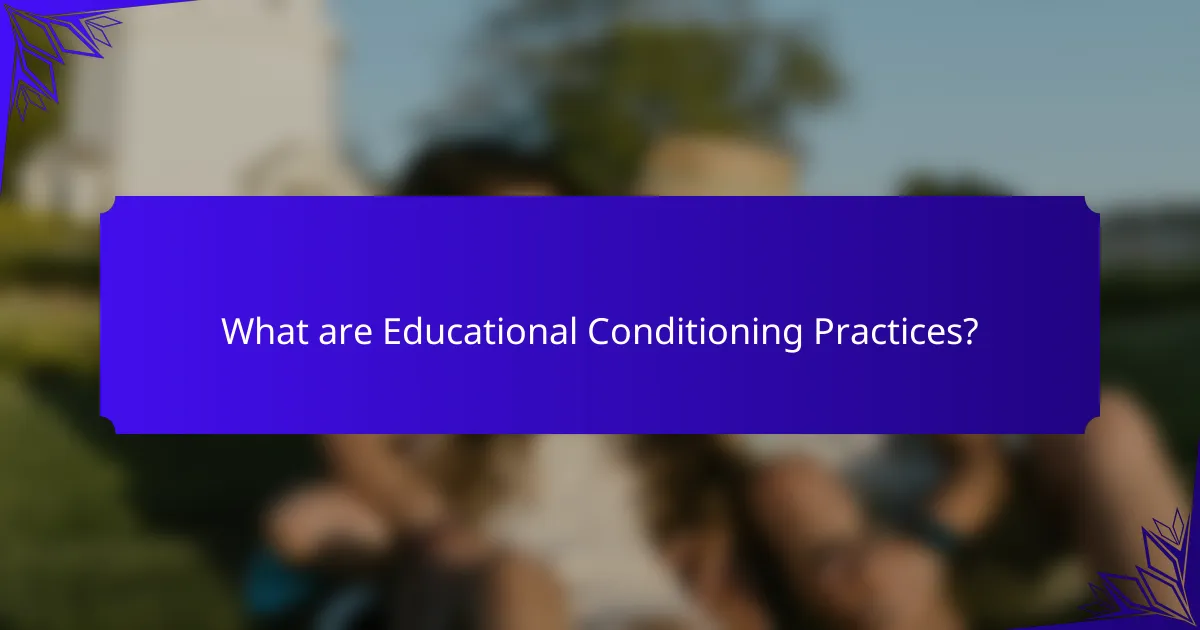
What are Educational Conditioning Practices?
Educational conditioning practices focus on enhancing engagement, retention, and adaptability in modern learning environments. These practices utilize techniques that promote active participation and personalized learning experiences.
By incorporating elements such as feedback loops, gamification, and adaptive learning technologies, educators can significantly improve student outcomes. For instance, gamification can increase motivation by making learning more enjoyable and competitive, while adaptive learning tailors content to individual student needs, fostering deeper understanding.
Research indicates that these practices can lead to higher retention rates, with studies showing up to a 30% increase in knowledge retention when interactive methods are employed. The unique attribute of educational conditioning practices is their ability to create a responsive learning environment that adjusts to diverse learner profiles, ultimately enhancing educational effectiveness.
How do Educational Conditioning Practices differ from traditional methods?
Educational conditioning practices prioritise active engagement and adaptability, differing significantly from traditional methods that often rely on passive learning. Traditional methods focus on rote memorisation and standardised assessments, while educational conditioning emphasises personalised learning experiences and real-time feedback. This approach enhances retention by fostering deeper connections to the material, allowing learners to apply knowledge in practical situations. Additionally, educational conditioning practices adapt to individual learning styles, promoting a more inclusive environment that caters to diverse needs. As a result, learners become more motivated and effective in their educational journeys.
What role does technology play in modern Educational Conditioning Practices?
Technology plays a crucial role in modern educational conditioning practices by enhancing engagement, retention, and adaptability. Digital tools facilitate personalised learning experiences through adaptive learning platforms that adjust content to individual student needs. Interactive technologies, such as gamification and virtual reality, create immersive environments that boost motivation and retention. Additionally, data analytics provide educators with insights into student performance, allowing for timely interventions and tailored instructional strategies. These advancements foster a more dynamic learning atmosphere that addresses diverse learning styles and improves overall educational outcomes.

What are the universal benefits of Educational Conditioning Practices?
Educational conditioning practices enhance engagement, retention, and adaptability in learning environments. These practices foster a deeper connection between students and content, leading to improved learning outcomes.
One significant benefit is increased engagement, as interactive techniques capture students’ attention. For example, gamification elements motivate learners by making education more enjoyable.
Retention is another critical advantage, as these practices promote active learning. Techniques like spaced repetition help solidify knowledge over time, making it easier for students to recall information during assessments.
Lastly, adaptability is enhanced through personalised learning experiences. Tailoring educational approaches to individual needs allows students to progress at their own pace, fostering a more inclusive learning environment.
How do these practices enhance student engagement?
Educational conditioning practices significantly enhance student engagement by fostering active participation and personalised learning experiences. These practices, such as gamification and collaborative projects, encourage students to take ownership of their education. As a result, they become more motivated and invested in their learning journey. Furthermore, adaptive learning technologies tailor content to individual needs, ensuring that students remain challenged yet supported. This personalised approach leads to improved retention rates and deeper understanding of the material. Overall, these practices create a dynamic and interactive learning environment that promotes sustained engagement.
What impact do they have on information retention?
Educational conditioning practices significantly enhance information retention by promoting active engagement and adaptability in learners. Techniques such as spaced repetition and interactive learning foster deeper cognitive connections, leading to improved memory recall. Research indicates that students exposed to these methods retain information up to 30% longer compared to traditional rote memorisation. Engaging learners through varied modalities, such as visuals and hands-on activities, further solidifies retention by catering to different learning styles. As a result, educational conditioning practices create a more effective learning environment, ultimately boosting long-term knowledge retention.
In what ways do they foster adaptability in learners?
Educational conditioning practices foster adaptability in learners by promoting critical thinking, encouraging problem-solving, and enhancing resilience. These practices create dynamic learning environments that respond to individual needs, allowing learners to adjust their strategies effectively. For example, incorporating collaborative projects helps students develop flexibility in their approaches. Additionally, the use of technology in education provides diverse resources that cater to various learning styles, further supporting adaptability. By integrating feedback mechanisms, educators can guide learners in refining their skills and adapting to new challenges.
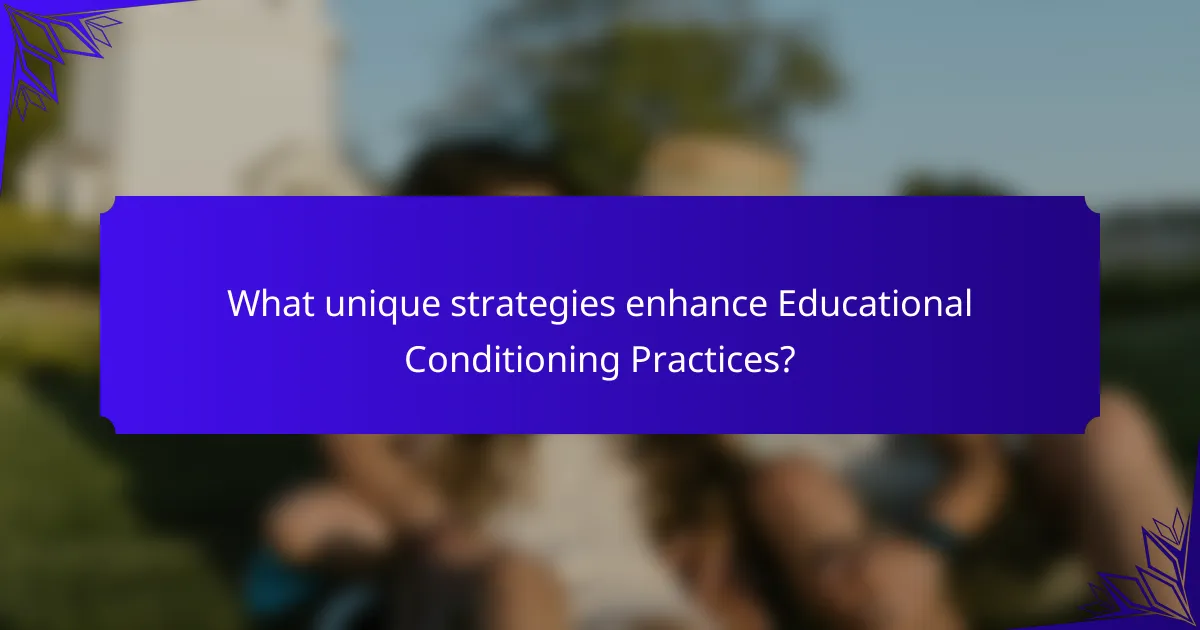
What unique strategies enhance Educational Conditioning Practices?
Unique strategies that enhance Educational Conditioning Practices include personalised learning pathways, gamification techniques, and the integration of technology. Personalised learning pathways allow educators to tailor content to individual student needs, improving engagement and retention. Gamification techniques, such as point systems and rewards, foster motivation and create a more interactive learning environment. The integration of technology, including adaptive learning platforms, facilitates real-time feedback and supports diverse learning styles, enhancing adaptability in modern learning environments.
How can gamification be effectively integrated?
Integrating gamification effectively enhances engagement in educational conditioning practices. Start by identifying clear learning objectives that align with game mechanics. Incorporate elements like points, badges, and leaderboards to motivate learners. Use storytelling to create immersive experiences that resonate emotionally. Regularly assess and adapt strategies based on learner feedback to ensure continuous improvement.
What are the advantages of personalised learning experiences?
Personalised learning experiences enhance engagement, retention, and adaptability by tailoring education to individual needs. These practices foster deeper understanding and motivation, leading to improved academic performance. For instance, students receiving customised content are more likely to stay engaged and retain information longer. Furthermore, personalised learning supports diverse learning styles, allowing each student to progress at their own pace. As a result, educational conditioning practices create a more effective learning environment that adapts to the unique attributes of each learner.
How does collaborative learning influence outcomes?
Collaborative learning significantly enhances educational outcomes by fostering engagement, retention, and adaptability. This approach encourages active participation, allowing learners to share diverse perspectives and deepen understanding. Research indicates that students involved in collaborative learning environments demonstrate higher retention rates, often exceeding traditional methods by up to 50%. Additionally, collaborative practices cultivate adaptability, equipping learners with essential skills for real-world problem-solving. Such environments promote a sense of community, which further motivates students to engage and succeed.

What rare attributes can set Educational Conditioning Practices apart?
Educational Conditioning Practices can be distinguished by their rare attributes, such as personalised feedback mechanisms, integration of neuroplasticity principles, and adaptive learning pathways. These elements enhance learner engagement and retention by tailoring experiences to individual needs. Additionally, the use of gamification techniques in educational conditioning fosters motivation through interactive challenges, making learning more appealing. Finally, the incorporation of real-time data analytics allows for immediate adjustments in teaching strategies, further setting these practices apart in modern learning environments.
What innovative assessment methods are being utilized?
Innovative assessment methods include adaptive testing, project-based evaluations, and peer assessments. These approaches enhance engagement by tailoring evaluations to individual learning paces. Adaptive testing adjusts difficulty based on responses, improving retention by challenging students appropriately. Project-based evaluations foster real-world application of knowledge, promoting adaptability in diverse contexts. Peer assessments encourage collaboration and critical thinking, vital for modern learning environments.
How can real-world problem-solving be incorporated?
Real-world problem-solving can be incorporated through project-based learning, simulations, and case studies. These methods enhance engagement by allowing students to apply theoretical knowledge to practical situations. Project-based learning encourages collaboration, critical thinking, and adaptability, essential skills in modern learning environments. Simulations provide immersive experiences that mimic real-world challenges, helping students develop problem-solving strategies. Case studies allow for in-depth analysis of real scenarios, fostering analytical skills and practical application of concepts. Integrating these approaches results in a more dynamic and relevant educational experience.
What are the implications of cultural responsiveness in these practices?
Cultural responsiveness in educational conditioning practices enhances engagement and retention by acknowledging diverse backgrounds. It fosters inclusivity, allowing learners to connect personally with content. This approach increases adaptability, ensuring that teaching methods resonate with varied cultural perspectives. As a result, students feel valued and understood, promoting a positive learning environment.
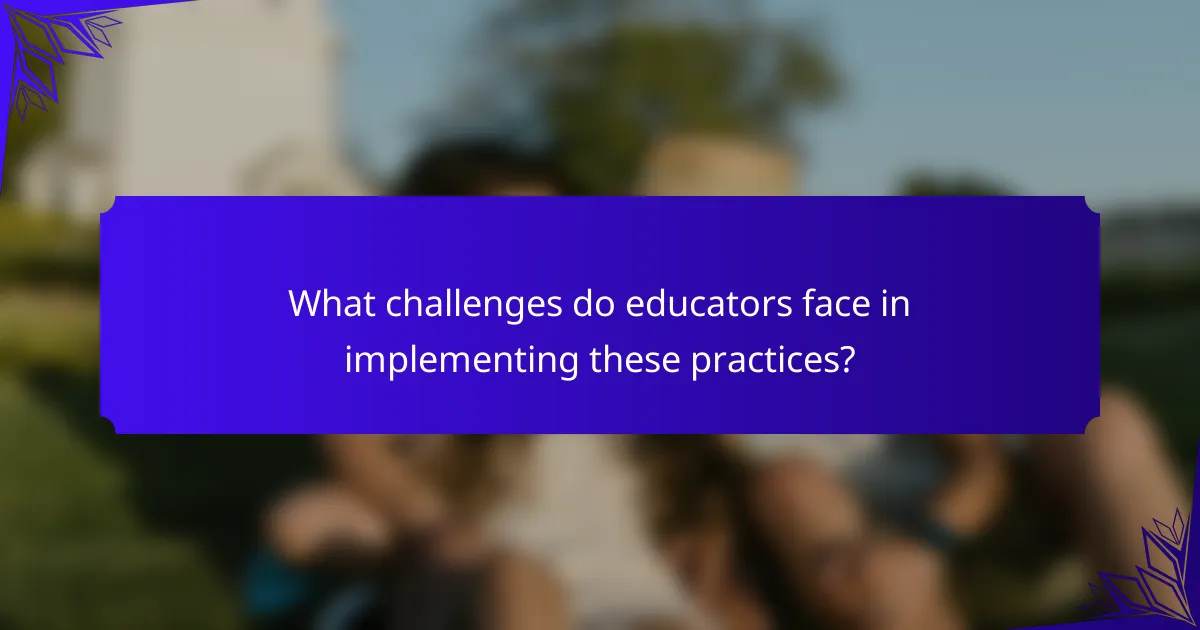
What challenges do educators face in implementing these practices?
Educators face numerous challenges in implementing educational conditioning practices. Resistance to change among faculty can hinder adoption. Limited resources, including time and training, restrict effective implementation. Additionally, varying student needs complicate the application of these practices. Inconsistent administrative support can further undermine efforts to enhance engagement and retention.
What are common misconceptions about Educational Conditioning Practices?
Common misconceptions about Educational Conditioning Practices include the belief that they are solely about rote memorisation, that they lack flexibility, and that they only benefit certain types of learners. In reality, these practices enhance engagement by promoting active participation, foster retention through diverse learning methods, and adapt to individual needs. Additionally, some think these practices are outdated; however, they are continually evolving to incorporate technology and modern pedagogical theories. Understanding these nuances can significantly improve educational outcomes.
How can resistance to change be addressed?
Resistance to change can be addressed through targeted educational conditioning practices. These practices foster engagement and adaptability, enabling learners to embrace new methods and ideas. Implementing strategies such as personalised learning experiences, collaborative projects, and continuous feedback loops can significantly enhance retention and acceptance of change. For instance, incorporating gamification techniques can motivate learners, making the transition smoother and more appealing. Additionally, emphasising the benefits of change, such as improved outcomes and skills development, can further mitigate resistance.
What resources are essential for successful implementation?
Successful implementation of educational conditioning practices requires a combination of strategic resources. Key resources include trained educators, technology tools, curriculum design frameworks, and assessment methods.
Trained educators possess the skills to apply conditioning techniques effectively, enhancing student engagement. Technology tools, such as learning management systems, facilitate interactive learning experiences. Curriculum design frameworks ensure content is structured to promote retention and adaptability. Assessment methods provide feedback for continuous improvement in teaching strategies.
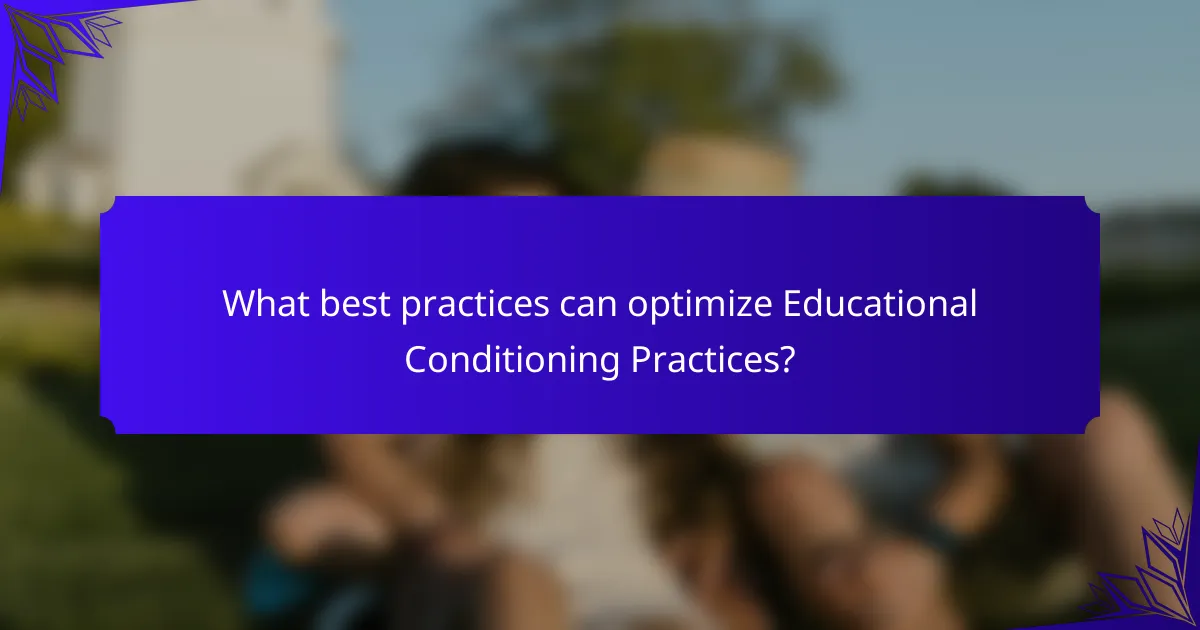
What best practices can optimize Educational Conditioning Practices?
To optimize Educational Conditioning Practices, implement active learning techniques, utilize technology for personalised experiences, and foster a supportive community. These strategies enhance engagement, retention, and adaptability in modern learning environments.
1. Incorporate active learning: Encourage participation through discussions, group work, and hands-on activities.
2. Leverage technology: Use adaptive learning platforms to tailor educational experiences to individual needs.
3. Foster collaboration: Create a community atmosphere that promotes peer support and shared learning.
4. Provide feedback: Offer timely and constructive feedback to guide learners’ progress.
5. Encourage self-directed learning: Empower students to take charge of their educational journey through goal-setting and reflection.
How can feedback loops enhance learning experiences?
Feedback loops significantly enhance learning experiences by providing continuous assessment and adjustment opportunities. They promote engagement by allowing learners to reflect on their understanding and receive timely guidance. This iterative process fosters retention, as learners can identify knowledge gaps and address them promptly. Additionally, feedback loops encourage adaptability, enabling educators to modify instructional strategies based on learner responses, ultimately creating a more personalised learning environment.
What are the key elements of a successful implementation plan?
A successful implementation plan for educational conditioning practices includes clear objectives, stakeholder engagement, resource allocation, timeline establishment, and assessment strategies.
1. Define clear objectives to enhance engagement, retention, and adaptability.
2. Engage stakeholders to ensure buy-in and collaboration.
3. Allocate necessary resources, including technology and training.
4. Establish a realistic timeline for implementation phases.
5. Develop assessment strategies to measure effectiveness and make adjustments.
What common mistakes should be avoided during application?
To avoid common mistakes during application of educational conditioning practices, focus on clarity, consistency, and engagement. Ensure that objectives are clearly defined and aligned with learner needs. Inconsistent messaging can confuse learners, reducing retention. Lack of interactive elements may lead to disengagement, so incorporate varied activities that promote active participation. Additionally, neglecting to assess learner progress can hinder adaptability; regular feedback is essential for improvement. Finally, avoid overwhelming learners with excessive information, as this can detract from their learning experience.
What expert insights can guide future developments?
Expert insights emphasize the need for innovative educational conditioning practices that enhance engagement and adaptability. Incorporating technology, such as adaptive learning systems, can personalise educational experiences, leading to improved retention rates. Research indicates that interactive methods, like gamification, significantly boost student motivation. Additionally, fostering a growth mindset in learners encourages resilience and adaptability in diverse learning environments. Continuous professional development for educators ensures they are equipped to implement these practices effectively, ultimately transforming modern learning landscapes.
